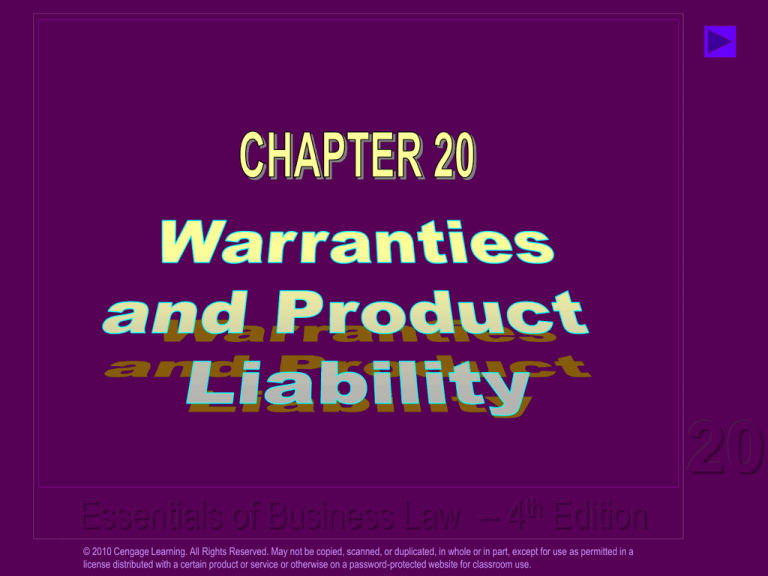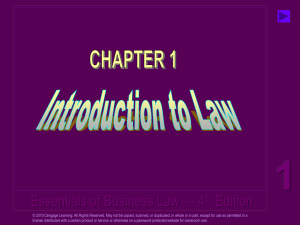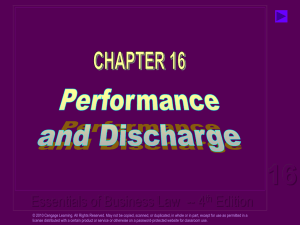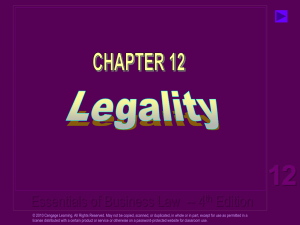
20
Essentials of Business Law -- 4th Edition
© 2010 Cengage Learning. All Rights Reserved. May not be copied, scanned, or duplicated, in whole or in part, except for use as permitted in a
license distributed with a certain product or service or otherwise on a password-protected website for classroom use.
Click your mouse
anywhere on the
screen when you are
ready to advance the
text within each slide.
After the starburst appears behind the blue
triangles, the slide is completely shown.
You may click one of the blue triangles to
move to the next slide or the previous slide.
Essentials of Business Law -- 4th Edition
© 2010 Cengage Learning. All Rights Reserved. May not be copied, scanned, or duplicated, in whole or in part, except for use as permitted in a
license distributed with a certain product or service or otherwise on a password-protected website for classroom use.
20
“Still one thing more, fellow citizens -- a
wise and frugal government, which shall
restrain men from injuring one another
[and] which shall leave them otherwise
free to regulate their own pursuits of
industry and improvement.”
Thomas Jefferson,
American president, in his first inaugural address
20
Essentials of Business Law -- 4th Edition
© 2010 Cengage Learning. All Rights Reserved. May not be copied, scanned, or duplicated, in whole or in part, except for use as permitted in a
license distributed with a certain product or service or otherwise on a password-protected website for classroom use.
When goods cause injury, there is a
question of product liability.
There are three main issues related to
product liability cases:
• Warranty -- a contractual assurance that
goods will meet certain standards.
• Negligence – unreasonable conduct by the
defendant.
• Strict Liability – policy which holds the
defendant liable regardless of his behavior.
Essentials of Business Law -- 4th Edition
© 2010 Cengage Learning. All Rights Reserved. May not be copied, scanned, or duplicated, in whole or in part, except for use as permitted in a
license distributed with a certain product or service or otherwise on a password-protected website for classroom use.
20
An express warranty is one that the seller
creates with his words or actions.
Any affirmation of fact--or any promise--can
create an express warranty.
• Statement is more likely to be affirmation of fact if it
is specific & provable, written, not obviously false,
and made by a seller with more experience than the
buyer.
Any description of the goods can create an
express warranty.
Any sample or model can create an express
warranty.
The seller’s conduct must have been part of
the basis of the bargain.
Essentials of Business Law -- 4th Edition
© 2010 Cengage Learning. All Rights Reserved. May not be copied, scanned, or duplicated, in whole or in part, except for use as permitted in a
license distributed with a certain product or service or otherwise on a password-protected website for classroom use.
20
Are created by the Code itself, not by
any act or statement of the seller.
Implied Warranty of Merchantability
• Unless excluded or modified, a warranty
that the goods shall be merchantable is
implied in a contract for their sale, if the
seller is a merchant of goods of that kind.
20
Essentials of Business Law -- 4th Edition
© 2010 Cengage Learning. All Rights Reserved. May not be copied, scanned, or duplicated, in whole or in part, except for use as permitted in a
license distributed with a certain product or service or otherwise on a password-protected website for classroom use.
Implied Warranty of Fitness for a
Particular Purpose
• When the seller at the time of contracting
knows about a particular purpose for which
the buyer wants the goods, and knows that
the buyer is relying on the seller’s skill and
judgement, there is (unless excluded or
modified) an implied warranty that the
goods shall be fit for such purpose.
20
Essentials of Business Law -- 4th Edition
© 2010 Cengage Learning. All Rights Reserved. May not be copied, scanned, or duplicated, in whole or in part, except for use as permitted in a
license distributed with a certain product or service or otherwise on a password-protected website for classroom use.
The seller of goods warrants that her
title is valid and that the goods are free
of any security interest that the buyer
knows nothing about, unless the seller
has clearly excluded or modified this
warranty.
Unless otherwise agreed, a merchant
warrants that the goods are free of any
rightful claim of copyright, patent, or
trademark infringement.
Essentials of Business Law -- 4th Edition
© 2010 Cengage Learning. All Rights Reserved. May not be copied, scanned, or duplicated, in whole or in part, except for use as permitted in a
license distributed with a certain product or service or otherwise on a password-protected website for classroom use.
20
Disclaimer: a statement that a particular
warranty does not apply.
• Oral Express Warranties – may be
disclaimed.
• Written Express Warranties – may NOT be
disclaimed.
• Implied Warranties of Merchantability –
may disclaim, but must use word
“merchantability” and the disclaimer must
be conspicuous.
Essentials of Business Law -- 4th Edition
© 2010 Cengage Learning. All Rights Reserved. May not be copied, scanned, or duplicated, in whole or in part, except for use as permitted in a
license distributed with a certain product or service or otherwise on a password-protected website for classroom use.
20
Seller may disclaim implied warranties
with the terms “as-is” or “with all faults.”
Many states prohibit disclaimers in the
sales of consumer goods.
Remedy Limitations
• A limitation of remedy clause, by which the
parties may limit or exclude the normal
remedies, is permitted under the Code.
Consequential Damages
• An exclusion of consequential damages is
void if it is unconscionable.
Essentials of Business Law -- 4th Edition
© 2010 Cengage Learning. All Rights Reserved. May not be copied, scanned, or duplicated, in whole or in part, except for use as permitted in a
license distributed with a certain product or service or otherwise on a password-protected website for classroom use.
20
When two parties contract, they are in
privity. In the past, injured parties could
only sue the party with whom he had
privity. This has changed.
• In cases of personal injury, the injured party
may sue any responsible party, regardless
of privity.
• In cases of economic loss, the injured party
may be required to have privity with the
defendant.
Essentials of Business Law -- 4th Edition
© 2010 Cengage Learning. All Rights Reserved. May not be copied, scanned, or duplicated, in whole or in part, except for use as permitted in a
license distributed with a certain product or service or otherwise on a password-protected website for classroom use.
20
Buyer’s Misconduct
• Misuse of the product by the buyer will
generally preclude a warranty claim.
Statute of Limitations and Notice of
Breach
• The Code prescribes a four-year statute of
limitations.
• The UCC requires that a buyer notify the
seller of defects within a reasonable time.
Essentials of Business Law -- 4th Edition
© 2010 Cengage Learning. All Rights Reserved. May not be copied, scanned, or duplicated, in whole or in part, except for use as permitted in a
license distributed with a certain product or service or otherwise on a password-protected website for classroom use.
20
In negligence cases, plaintiffs most
often raise one or more of these claims:
• Negligent design
• Negligent manufacture
• Failure to warn
Where a sales contract includes proper
disclaimers or remedy limitations, a
buyer barred from a negligence case
may have no remedy at all.
Essentials of Business Law -- 4th Edition
© 2010 Cengage Learning. All Rights Reserved. May not be copied, scanned, or duplicated, in whole or in part, except for use as permitted in a
license distributed with a certain product or service or otherwise on a password-protected website for classroom use.
20
Need not prove that the defendant’s
conduct was unreasonable.
Strict liability may be imposed if:
• The defective condition is unreasonably
dangerous to the user.
• Seller is in business to sell this product.
• The product reaches the user without
substantial change.
Strict liability may be imposed EVEN if:
• The seller exercised all reasonable care.
• There is no contractual relationship.
Essentials of Business Law -- 4th Edition
© 2010 Cengage Learning. All Rights Reserved. May not be copied, scanned, or duplicated, in whole or in part, except for use as permitted in a
license distributed with a certain product or service or otherwise on a password-protected website for classroom use.
20
Strict liability may be imposed based on
design, manufacture or failure to warn.
Tests to measure design and warning
cases include:
• Consumer expectation: if the design causes
the product to be less safe than expected
• Risk-utility tests: weigh the value of the
product, gravity and likelihood of the danger,
feasibility of a safer design, and adverse
consequences of a safer design.
Essentials of Business Law -- 4th Edition
© 2010 Cengage Learning. All Rights Reserved. May not be copied, scanned, or duplicated, in whole or in part, except for use as permitted in a
license distributed with a certain product or service or otherwise on a password-protected website for classroom use.
20
In manufacturing cases, a product is
defective whenever it departs from its
intended design, regardless of how
much care was taken.
In design and warnings cases, a
product is defective only when the
foreseeable risks of harm could have
been reduced by using a reasonable
alternative design or warning.
Essentials of Business Law -- 4th Edition
© 2010 Cengage Learning. All Rights Reserved. May not be copied, scanned, or duplicated, in whole or in part, except for use as permitted in a
license distributed with a certain product or service or otherwise on a password-protected website for classroom use.
20
About half the states have passed limitations
on tort awards. Though they vary among
states, a typical rule is:
• A jury is permitted to award whatever it considers
fair for economic damages, meaning lost wages
and medical expenses.
• Non-economic damages (pain and suffering),
together with any punitive award, may not exceed
a prescribed limit, such as three times the
economic damages, or sometimes a flat cap, such
as $250,000 total.
Essentials of Business Law -- 4th Edition
© 2010 Cengage Learning. All Rights Reserved. May not be copied, scanned, or duplicated, in whole or in part, except for use as permitted in a
license distributed with a certain product or service or otherwise on a password-protected website for classroom use.
20
Statutes of Limitations in Tort
• Economic loss doctrine: when an injury is
purely economic, and arises from a contract
made by two businesses, the injured party
may only sue under the UCC.
• The four-year statute of limitations will
apply in all cases of economic loss.
A Final Issue: Statutes of Repose
• A statute of repose places an absolute limit
on when a lawsuit may be filed, regardless
of when the defect is discovered.
Essentials of Business Law -- 4th Edition
© 2010 Cengage Learning. All Rights Reserved. May not be copied, scanned, or duplicated, in whole or in part, except for use as permitted in a
license distributed with a certain product or service or otherwise on a password-protected website for classroom use.
20
Lemon Laws
• Entitle buyers of cars to return them for a
refund after a reasonable time if the car has
substantial defects.
Consumer Protection Laws
• Focus on a merchant’s bad faith or deceit.
Magnuson-Moss Warranty Act
• Protects purchasers of household goods
by ensuring fairness in warranties.
Essentials of Business Law -- 4th Edition
© 2010 Cengage Learning. All Rights Reserved. May not be copied, scanned, or duplicated, in whole or in part, except for use as permitted in a
license distributed with a certain product or service or otherwise on a password-protected website for classroom use.
20
20
Essentials of Business Law -- 4th Edition
© 2010 Cengage Learning. All Rights Reserved. May not be copied, scanned, or duplicated, in whole or in part, except for use as permitted in a
license distributed with a certain product or service or otherwise on a password-protected website for classroom use.








